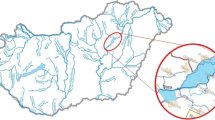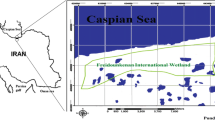Abstract
Metal (arsenic, mercury, cadmium, lead, nickel, cobalt and manganese) concentrations were analyzed in muscles, livers and ventral plumage of Tree Sparrows (Passer montanus). Differences in metal concentrations between adults and chicks, inter-clutch and species were studied. The levels of metals accumulated with age, and the adults have higher concentrations of metals. Female had lower mercury level than that in male, which means female can excrete mercury by egg-laying. The eggs laid in the first brood had relatively higher concentrations of metals than those in the second ones. For different species, the location they habitat is more important when they share a similar diet and circumstance.
Similar content being viewed by others
Explore related subjects
Discover the latest articles, news and stories from top researchers in related subjects.Avoid common mistakes on your manuscript.
Many industrial processes produce large quantities of metals as by-product and these end-up in plant and animal species in natural ecosystems. Metals concentrations in birds have been concerned by researchers for years (Golden et al. 2003). Most of the monitoring studies focus on raptors and sea birds (Wayland et al. 1999; Goutner et al. 2001). There are few on passerine birds (Janssens et al. 2002; Dauwe et al. 2003), especially on Tree Sparrow. Tree Sparrow is widely distributed in Europe and Asia, small introduced populations in North America and Australia. It is a sedentary species and always forages near towns, farms and other places close to human in Beijing. Its home range is small, only about 7,600 m2 (Pan et al. 2003). The above indicate that it might be a proper species to monitor the local environment.
In this paper, we report on arsenic, mercury, cadmium, lead, nickel, cobalt and manganese concentrations in muscle, liver and feathers in Tree Sparrow. Our objective is to determine whether age, gender and species can affect the levels of metals in Tree Sparrow.
Materials and Methods
The study was carried out at Beijing Normal University, Liulihe Cement Plant and Capital Steel Company. The university lies in the center of Beijing, and the traffic jam nearby is the important origin of pollutant. Liulihe cement plant and Capital steel company are serious contaminated districts in Beijing. Samples were collected under license from the Beijing Forest Bureau from three sites in Beijing.
We compared metal levels in the muscles, livers and feathers of the Tree Sparrow in the three locations. Pectoral muscle, livers and feathers were analyzed for arsenic, mercury, cadmium, lead, nickel, cobalt and manganese. Samples for analysis were dried at a temperature of 65°C. They were then homogenized with the aid of porcelain pestle and mortar and then dried until there was no further weight loss. From each sample about 0.2 g (dry weight) was taken and to this was added 1 mL of a 4:1 mixture of concentrated nitric acid and perchloric acid. The mixtures were then heated at 160°C for about 4 h to obtain a colorless, clear solution. After cooling, each mixture was poured into a numbered container and topped up 10 mL with double-distilled water and stirred.
Metal levels were measured using an axial inductively coupled plasma-atomic emission spectrophotometer (ICP-AES) by JY-ULTIMA. A standard calibration curve was obtained using a blank and certified reference material from the National Research Center for Certified Reference Materials (Beijing).
Nonparametric Mann–Whitney U test was applied to test for differences in metal concentrations between samples from different sites. A significance level of 0.05 was chosen for all statistical tests.
Results and Discussion
In total, we collected eight chicks and eight adults respectively in breeding season, 2002. We compared the levels of metals in tissues between adult and nestlings in Beijing Normal University.
The concentrations of metals in muscles of adult Tree Sparrow are higher than in chicks except nickel. Mercury level shows a significant difference (Table 1). Metals levels in liver and ventral feathers in adult are higher, and there are significant differences between adult and fledging Tree Sparrow of lead and nickel in liver and manganese in ventral plumage (Table 1).
From this study, we can see that metals in adult are higher than those in chicks, which matched with Burger’s studies in 1999.
Metals like arsenic, mercury, cadmium, lead, cobalt and manganese in tissues accumulated with age, while nickel in muscle showed a different trend. This indicates that age of exposure time is a dominant factor for metal accumulation in birds. The decrease of nickel in muscle might be explained by molting of adult.
We collected 18 eggs in first brood and 20 in second. By comparing the inter-clutch variation of metal concentrations in eggs, we can see that mercury level in the first brood is higher than it in the second brood, while cadmium, nickel and manganese concentrations are significantly lower (Table 2).
Mercury in eggs for the first brood is higher remarkably than that in the second. In Beijing, the breeding season extends from mid-April to August.
Tree Sparrow has about three broods each year (Ruan and Zheng 1991). The intervals between broods are short. As some elements in muscles and livers of adults can excrete by laying eggs, the second brood will get a relatively lower metal accumulation than those in the first one.
We caught 11 females and 8 male Tree Sparrow totally in the University and the Steel Company. Female and male share the different elements levels in tissues. Arsenic concentrations in males are lower while others are higher than those in females (Table 3). There is no significant difference of the metals between female and male.
Totally we collected feathers from 4 Eurasian Hoopoe (Upupa epops) and 13 Tree Sparrow. Metals concentrations in ventral plumage of Tree Sparrow are higher than those in Eurasian Hoopoe. There are significant difference of arsenic, mercury, cadmium, nickel and lead between the two species (Table 4).
Metals concentrations in ventral plumage for Tree Sparrow were notably higher than those for Eurasian Hoopoe. The samples were collected at the same sites and their diets are similar during the breeding season. Tree Sparrow is polyphagous but feeds primarily on insects during breed season. Eurasian Hoopoe mainly eats insects and worms. However, Tree Sparrow is a resident bird while Eurasian Hoopoe is summer migrant in Beijing. Hoopoe migrates to the breeding site near Liulihe in March. Burger and Gochfeld (1997) reported that the concentrations of metals in feathers partly depend on the pollution levels in pre-migration. Lower levers metal in Hoopoes indicates that the environmental situation of the sites they stayed before migration has a comparatively good quality. Although they forage in the same place, the differences on diets and territory influenced the metals level.
References
Burger J, Gochfeld M (1997) Risk, mercury levels and birds: relating adverse laboratory effects to field biomonitoring. Environ Res 75:160–172
Burger J, Gochfeld M (1999) Heavy metals in Franklin’s gull tissues: age and tissue differences. Environ Toxicol Chem 18(4):673–678
Dauwe T, Chu SG, Covaci A, Schepens P, Eens M (2003) Great Tit (Parus major) Nestlings as Biomonitors of Organochlorine Pollution. Arch Environ Contam Toxicol 44:89–96
Golden NH, Rattner BA, McGowan PC, Parsons KC, Ottinger MA (2003) Concentrations of metals in feathers and blood of nestling black-crowned night-herons (Nycticorax nycticorax) in Chesapeake and Delaware Bays. Bull Environ Contam Toxicol 70:385–393
Goutner V, Furness RW, Papakostas G (2001) Mercury in feathers of Squacco Heron (Ardeola ralloides) chicks in relation to age, hatching order, growth, and sampling dates. Environ Pollut 111(1):107–115
Janssens E, Dauwe T, Bervoets L, Eens M (2002) Inter- and intraclutch variability in heavy metals in feathers of Great Tit Nestlings (Parus major) along a pollution gradient. Arch Environ Contam Toxicol 43:323–329
Pan Chao, Zheng GM, Zhang ZW (2003) Studies on home range of Tree Sparrow in Beijing Normal University in Winter. J Beijing Normal Univ (Nat Sci) 39(4):537–540
Ruan X, Zheng G (1991) Breeding ecology of Tree Sparrow (Passer montanus) in Beijing. In: Pinwski J, Kavanagh BP, Gorski W (eds) Nestling mortality of granivorous birds due to microorganisms and toxic substances. PWN-Polish Sci., Warszawa, pp 99–109
Wayland M, Neugebauer E, Bollinger T (1999) Concentrations of lead in liver, kidney, and bone of Bald and Golden Eagles. Arch Environ Contam Toxicol 37:267–272
Acknowledgments
We thank Fang Chen and Daoping Song for help with the metal analysis, Long Xu, Ning Wang, and Yong Bai for help with the field work. This study was supported by the National Natural Science Foundation of China (No. 30170187) and Beijing Normal University.
Author information
Authors and Affiliations
Corresponding author
Rights and permissions
About this article
Cite this article
Pan, C., Zheng, G. & Zhang, Y. Concentrations of Metals in Liver, Muscle and Feathers of Tree Sparrow: Age, Inter-Clutch Variability, Gender, and Species Differences. Bull Environ Contam Toxicol 81, 558–560 (2008). https://doi.org/10.1007/s00128-007-9168-9
Received:
Accepted:
Published:
Issue Date:
DOI: https://doi.org/10.1007/s00128-007-9168-9




